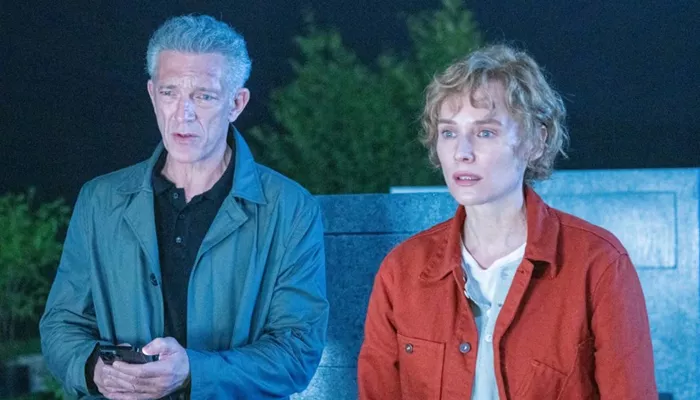David Cronenberg’s latest film, The Shrouds, examines grief, technology, and the intersection of the human body with the digital world. The film is both a personal reflection and a chilling look at how technology exploits human loss.
The story centers around Karsh (Vincent Cassel), an entrepreneur who capitalizes on death. His company, GraveTech, offers a disturbing service that lets people watch the decay of their deceased loved ones through cameras embedded in burial shrouds. Karsh’s own wife, Becca (Diane Kruger), is one of the deceased whose body is on display. The plot thickens when a rival sabotages Becca’s grave site, pulling Karsh into a web of conspiracy and corporate intrigue.
The Shrouds is Cronenberg’s most introspective film to date. It mixes elements of body horror with a meditation on how we memorialize the dead, particularly loved ones. The director’s exploration of loss is influenced by the recent deaths of his wife Carolyn Zeifman and sister Denise Cronenberg, who worked with him on many of his earlier films. Cronenberg’s grief is reflected in Karsh’s obsession with his late wife and his troubling relationship with her image, both through the app and through the presence of her sister, Terry (also played by Kruger).
The film critiques the commodification of human memory. Karsh, who refers to his deceased wife as nothing more than a “body,” is trying to turn grief into profit. In the film, the boundaries between life and death blur, as Becca’s image is immortalized in an app that turns death into a marketable spectacle.
Cronenberg’s direction is deliberately cold and detached, mirroring the emotional numbness that technology often brings to human experience. The film presents a world where human interaction is mediated by screens, and genuine connection has been replaced by artificial substitutes. In this universe, a Tesla or a digital avatar is more significant than the human body, which has been reduced to a data point.
The narrative takes on a conspiratorial tone as Karsh’s grief-driven business ventures are met with sabotage. As the film unfolds, the line between reality and paranoia becomes increasingly blurry. The psychological toll of loss drives Karsh to question not just his business practices, but his personal relationships, especially with his late wife’s doppelgänger, a Meta avatar named Hunny.
The Shrouds is not a typical horror film. While it includes elements of body horror, such as decaying corpses and strange bodily transformations, it is more an exploration of the soul-crushing effects of grief and the consequences of using technology to mediate it. The film examines how modernity inscribes itself onto the body, turning personal loss into a marketable product.
Cronenberg has always been fascinated by the relationship between the body and technology, and The Shrouds is no different. The film is a stark commentary on how we have become disconnected from the human body in favor of digital distractions. As with many of his films, The Shrouds challenges the viewer to think critically about how technology shapes our lives and our sense of self.
Ultimately, The Shrouds is a chilling reminder of how grief, technology, and corporate greed can intertwine in disturbing ways. It is a film about loss, but also about how that loss is often commodified in the modern world. With a minimalist approach to storytelling and a haunting atmosphere, Cronenberg’s latest work offers a cold but thought-provoking commentary on the state of humanity in the digital age.
David Cronenberg has once again used his cinematic vision to explore the darker aspects of modern life, and The Shrouds is a timely reflection on how grief and technology shape our current world.
Related topics:
- “The Shrouds”: Cronenberg’s Unsettling Take on Grief and Technology
- ‘Don’t Let the Cat Out’ to Premiere at Panic Fest 2025
- Overlook Film Festival 2025 Unveils First Wave Lineup

